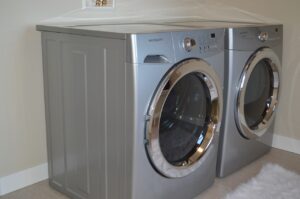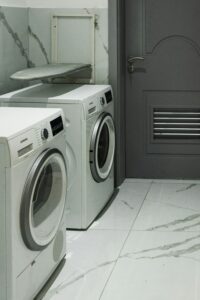A functioning dishwasher is a crucial appliance in any modern kitchen. It saves time and effort by efficiently cleaning and sanitizing dishes, allowing us to focus on other tasks. However, like any other appliance, dishwashers can experience problems that hinder their performance. This blog post aims to provide a comprehensive guide to troubleshooting and fixing common dishwasher problems. Whether you are a homeowner or a renter, understanding how to diagnose and address these issues promptly can help you avoid costly repairs or the need for a replacement.
Key Takeaways
- Common dishwasher problems include leaks, drainage issues, spray arm problems, motor malfunctions, heating element malfunctions, filter blockages, and door latch issues.
- Understanding the dishwasher system is important for diagnosing and fixing problems. The system includes the control panel, motor, spray arm, heating element, and drainage system.
- Diagnosing dishwasher leaks involves checking the door gasket, tub, and hoses. Leaks can be caused by a faulty gasket, loose connections, or a cracked tub.
- Troubleshooting dishwasher drainage issues involves checking the drain hose, garbage disposal, and air gap. Clogs or blockages can cause drainage problems.
- Fixing dishwasher spray arm problems involves checking for clogs or blockages in the spray arm and ensuring it is properly attached to the motor. A malfunctioning spray arm can cause poor cleaning performance.
- Identifying and replacing faulty dishwasher motors involves checking for unusual noises or a lack of movement. A malfunctioning motor can cause poor cleaning performance or prevent the dishwasher from running at all.
- Addressing dishwasher heating element malfunctions involves checking for a lack of heat or burnt out elements. A malfunctioning heating element can cause poor cleaning performance or prevent the dishwasher from running at all.
- Resolving dishwasher filter blockages involves cleaning or replacing the filter. A clogged filter can cause poor cleaning performance or prevent the dishwasher from running at all.
- Fixing dishwasher door latch issues involves checking for a loose or broken latch. A faulty latch can prevent the dishwasher from running or cause leaks.
- Maintaining optimal dishwasher performance involves regularly cleaning the dishwasher, checking for and fixing any problems, and using the dishwasher properly.
Common Dishwasher Problems and Symptoms
Before delving into the specifics of dishwasher troubleshooting, it is essential to familiarize ourselves with the common problems that can occur. Some of the most frequent issues include leaks, drainage problems, spray arm malfunctions, faulty motors, heating element malfunctions, filter blockages, and door latch issues.
Leaking is one of the most noticeable problems that can occur with a dishwasher. It can be caused by various factors, such as a damaged door seal, loose connections, or a cracked tub. Drainage problems can manifest as standing water in the bottom of the dishwasher or slow draining. Spray arm problems can result in inadequate cleaning and rinsing of dishes. Faulty motors can lead to the dishwasher not starting or not completing cycles. Heating element malfunctions can result in dishes not drying properly. Filter blockages can cause poor cleaning performance and unpleasant odors. Lastly, door latch issues can prevent the dishwasher from starting or interrupt cycles.
Understanding the Dishwasher System
To effectively troubleshoot and fix dishwasher problems, it is crucial to have a basic understanding of how the dishwasher system works. A typical dishwasher consists of several components that work together to clean dishes.
The main components include the control panel, which allows you to select different cycles and settings; the water inlet valve, which controls the flow of water into the dishwasher; the pump and motor assembly, which circulates water and powers the spray arms; the spray arms, which distribute water and detergent to clean the dishes; the heating element, which heats the water and aids in drying; the drain pump, which removes dirty water from the dishwasher; and the filters, which trap food particles and debris.
Diagnosing Dishwasher Leaks
When faced with a leaking dishwasher, it is essential to take immediate action to prevent further damage to your kitchen and appliances. The first step in diagnosing a dishwasher leak is to determine where the leak is coming from. Start by inspecting the door seal for any signs of damage or wear. If the door seal appears to be intact, check the connections between the water supply and the dishwasher for any leaks. Additionally, inspect the tub for any cracks or damage that may be causing the leak.
Common causes of dishwasher leaks include a worn-out door seal, loose or damaged connections, a cracked tub, or a faulty water inlet valve. If you identify any of these issues, they can usually be fixed by replacing the faulty component. However, if you are unsure about how to proceed or if the leak persists after attempting repairs, it is advisable to seek professional help.
Troubleshooting Dishwasher Drainage Issues
Drainage problems can be frustrating as they can result in standing water in the bottom of the dishwasher or slow draining. To troubleshoot drainage issues, start by checking for any visible blockages in the drain hose or air gap. Clearing these blockages can often resolve the problem.
If there are no visible blockages, check if the drain pump is functioning correctly. You can do this by listening for a humming sound when the dishwasher is supposed to be draining. If you hear a humming sound but no water is being pumped out, it indicates a problem with the drain pump. In this case, you may need to replace the drain pump.
Other common causes of drainage problems include a clogged filter or a faulty check valve. Cleaning the filter regularly can help prevent blockages and ensure proper drainage. If the check valve is faulty, it may need to be replaced to restore proper drainage.
Fixing Dishwasher Spray Arm Problems

Spray arm problems can result in dishes not being cleaned properly or rinsed thoroughly. To troubleshoot spray arm issues, start by checking for any blockages in the spray arm itself or the spray arm holes. Clearing these blockages can often resolve the problem.
If there are no visible blockages, check if the spray arm is spinning freely. A spray arm that is not spinning or is spinning slowly may indicate a problem with the pump and motor assembly. In this case, you may need to replace the pump and motor assembly to restore proper spray arm function.
Other common causes of spray arm problems include a faulty spray arm bearing or a clogged filter. If the spray arm bearing is worn out, it may need to be replaced. Cleaning the filter regularly can help prevent blockages and ensure proper spray arm function.
Identifying and Replacing Faulty Dishwasher Motors
A faulty motor can prevent the dishwasher from starting or completing cycles. To identify a faulty motor, start by checking if the dishwasher is receiving power. If the dishwasher is not starting at all, it may indicate a problem with the motor or another electrical component.
If the dishwasher starts but does not complete cycles, listen for any unusual noises coming from the motor. A grinding or buzzing sound may indicate a problem with the motor. In this case, you may need to replace the motor to restore proper dishwasher function.
Replacing a faulty motor can be a complex task that requires technical knowledge and expertise. If you are not confident in your abilities or if you are unsure about how to proceed, it is best to seek professional help.
Addressing Dishwasher Heating Element Malfunctions
A malfunctioning heating element can result in dishes not drying properly. To troubleshoot heating element malfunctions, start by checking if the heating element is receiving power. If the heating element is not getting power, it may indicate a problem with the control panel or another electrical component.
If the heating element is getting power but is not heating up, it may be faulty and need to be replaced. Before replacing the heating element, make sure to check for any visible signs of damage or wear. If the heating element appears to be intact, it is likely that it needs to be replaced to restore proper drying performance.
Resolving Dishwasher Filter Blockages
Filter blockages can cause poor cleaning performance and unpleasant odors. To troubleshoot filter blockages, start by removing and cleaning the filters according to the manufacturer’s instructions. This will help remove any trapped food particles or debris that may be causing the blockage.
If cleaning the filters does not resolve the issue, check for any visible blockages in the drain pump or the drain hose. Clearing these blockages can often restore proper filter function.
Regularly cleaning the filters and ensuring that they are free from blockages is essential for maintaining optimal dishwasher performance. It is also advisable to avoid rinsing dishes before placing them in the dishwasher, as this can lead to an accumulation of food particles in the filters.
Fixing Dishwasher Door Latch Issues
Door latch issues can prevent the dishwasher from starting or interrupt cycles. To troubleshoot door latch issues, start by inspecting the door latch for any visible signs of damage or wear. If the door latch appears to be intact, check if it is properly aligned with the door strike.
If the door latch is misaligned, you may need to adjust it to ensure a proper connection with the door strike. This can usually be done by loosening the screws that hold the latch in place and repositioning it.
If the door latch is damaged or worn out, it may need to be replaced to restore proper dishwasher function. Replacing a door latch can be a relatively simple task that can be done with basic tools and some technical knowledge.
Maintaining Optimal Dishwasher Performance
Regular maintenance is essential for ensuring optimal dishwasher performance and prolonging its lifespan. Some tips for maintaining a dishwasher’s optimal performance include:
1. Clean the filters regularly: Remove and clean the filters according to the manufacturer’s instructions to prevent blockages and maintain proper cleaning performance.
2. Run hot water before starting the dishwasher: Running hot water in the sink before starting the dishwasher helps ensure that the water entering the dishwasher is at the desired temperature.
3. Use the right detergent: Use a high-quality dishwasher detergent that is suitable for your dishwasher model and water hardness level.
4. Load the dishwasher properly: Avoid overcrowding the dishwasher and make sure that dishes are properly positioned to allow for proper water circulation.
5. Check for leaks and other issues regularly: Inspect the dishwasher for any signs of leaks, unusual noises, or other issues on a regular basis. Addressing these issues promptly can help prevent further damage and costly repairs.
In conclusion, addressing dishwasher problems promptly is crucial for maintaining a functioning appliance and avoiding costly repairs or replacements. By understanding common dishwasher problems and their symptoms, as well as how the dishwasher system works, you can effectively troubleshoot and fix these issues. However, it is important to remember that some repairs may require professional help, especially if you are not confident in your abilities or if the issue persists after attempting DIY fixes. Regular maintenance is also essential for ensuring optimal dishwasher performance and prolonging its lifespan.
If you’re experiencing issues with your dishwasher, it’s important to diagnose and fix them as soon as possible to avoid further damage. In addition to our comprehensive guide on Diagnosing and Fixing Dishwasher Issues, you may also find our article on “Common Dishwasher Problems and How to Solve Them” helpful. This article provides practical tips and solutions for common dishwasher issues such as leaks, strange noises, and poor cleaning performance. Check it out here for expert advice on keeping your dishwasher running smoothly.
Can Understanding Dishwasher Components Help in Diagnosing and Fixing Issues?
Mastering dishwasher basics can certainly assist in diagnosing and fixing issues. Understanding the various components such as the pump, filter, spray arm, and heating element can help pinpoint the source of problems and make the repair process much easier.



